As we know, hawker culture and the challenges hawkers are facing under new types of hawker centre configurations continues to be at the centre of significant online debate and concern.
Perhaps in view of this, on Monday, local website Vulcan Post conducted and published an interview with the CEO of NTUC Foodfare, one of the five social enterprises which are running social enterprise hawker centres.
"There’s nothing stopping these hawkers to operate [sic] in the NEA hawker centres"
In an article originally titled "NTUC Foodfare CEO: 'If You Think SEHCs Are Not Good Enough, Go To NEA'" (which was later taken down), Vulcan Post ran an interview with NTUC Foodfare CEO Perry Ong, which included answers from him to questions that included allegations made against SEHCs like the ones run by Foodfare.
Here's a quick summary of it:
On profiteering
In response to the allegation that SEHC operators are profiteering off hawkers, Ong said profits are needed to sustain the business and as part of its social enterprise nature, all the profit is channelled back into initiatives for hawkers, citing a hawkerpreneurship programme and financial assistance as examples.
"Ultimately, we need to make sure that the enterprise business is sustainable. But the profit that we actually make, we plough it all back into our social purpose and all the initiatives that we run."
On the higher costs levied on hawkers beyond stall rental
Ong was quoted saying that hawkers are facing higher ancillary costs because "[they] do not cheap source, [they] go for the best". He gave the example of contracting cleaning services:
"For cleaning contracts, we require cleaning companies to achieve a Clean Mark — that is the national standard, whereby companies need to make sure they pay a certain wage to their cleaners and send them for necessary up-skilling, amongst a list of other criteria. It is all part of the national effort to try and lift this industry, especially since the cleaning industry is the one that has a lot of cheap labour."
Ong also stated that monthly stall rental is pegged within the range of S$1,600 to S$2,200 — the median range for rental at NEA-run hawker centres.
Additionally, Ong reportedly said, Foodfare does not "want to drive up the rents. Once you do that, hawkers will be under pressure to [increase] their prices".
Ong did not directly address the matter of additional charges that result in increased operational costs for SEHC hawkers (in some cases, twice what a NEA hawker pays) that add pressure on them to increase the prices of their food. However, SEHC hawkers are still required to price at least one of their dishes below S$3, which puts them in a bind.
Low foot traffic amplifies cost challenges
Apart from this, Ong reportedly also noted that low foot traffic is another challenge, particularly at Pasir Ris Central Hawker Centre, which Foodfare manages:
"Unfortunately, for Pasir Ris Central Hawker Centre, the footfall is a bit weak so hawkers are finding it a little bit more difficult. Even though they have agreed upfront — in fact, they were very happy when they got selected — but when they realise that they don’t have enough business, it goes back to the cost."
Regarding termination clauses for hawkers who want to leave, Ong was quoted saying that Foodfare does not "hold on to the hawkers and make them be committed to the whole three-year lease".
Comparing between SEHCs and NEA-run hawker centres
He went to reportedly say that hawkers in SEHC might be discontented because they are comparing themselves with NEA hawkers:
"[My] hypothesis is that they are discontent because they are comparing two different areas: 1) their business is not doing as well as other hawkers so they find the going tough 2) they compare with other hawker centres that are non-social enterprise."
SEHCs are a little different from NEA-run hawker centres in terms of cleanliness, amenities and such, which might justify a higher operating cost.
Whether these amenities like "vibrancy" and coin-changing services are what hawkers want or need is another thing altogether, however. Ong was quoted saying that ultimately, if hawkers don't find that SEHCs are suitable places for them to operate, they have the "privilege of choice" to move to other hawker centres:
"Here’s the thing: there’s nothing stopping these hawkers to operate in the NEA hawker centres. There are constantly vacant stalls so the privilege of choice is there, bearing in mind that we do not impose penalty for uncompleted tenure."
HardwareZone users react
Unfortunately, Ong's last reply about hawkers "having the privilege of choice" to leave SEHCs triggered users on local forum HardwareZone, with many blasting what they perceived to be Ong's cavalier attitude towards hawkers.
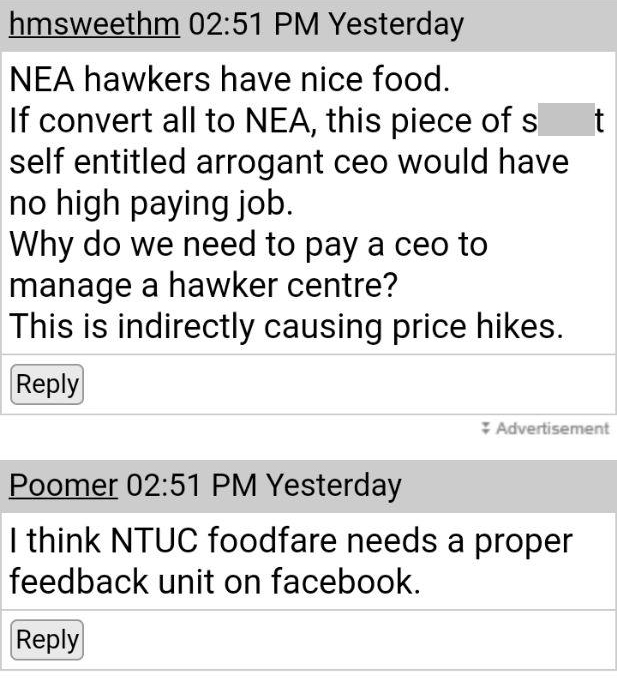
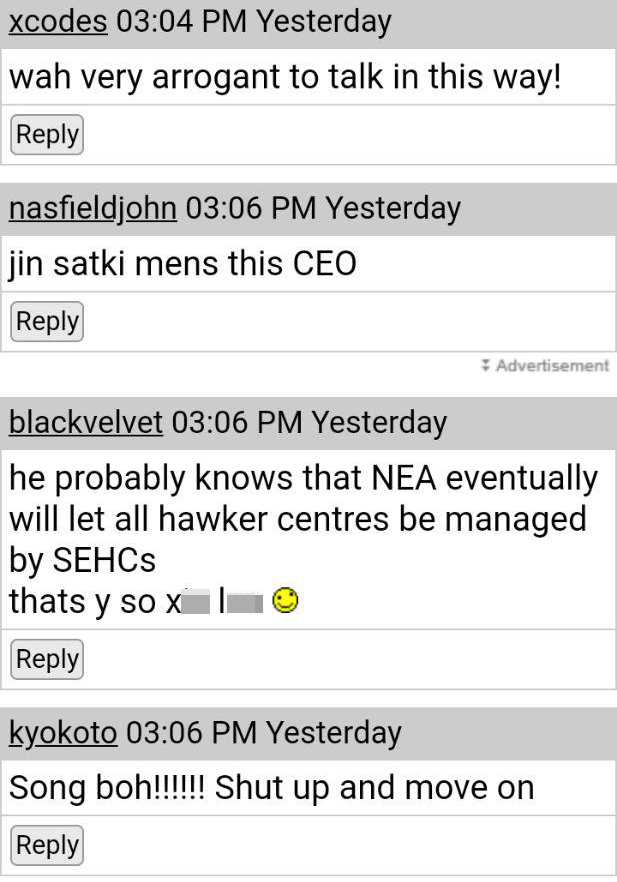

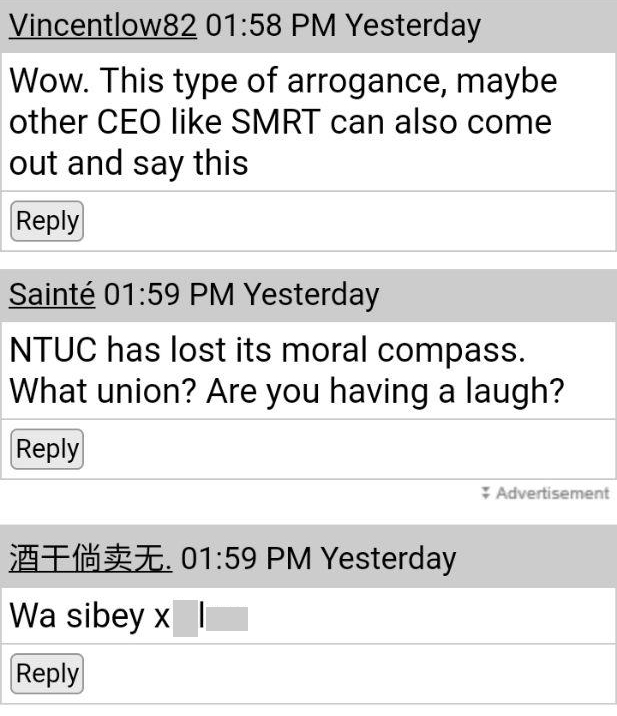
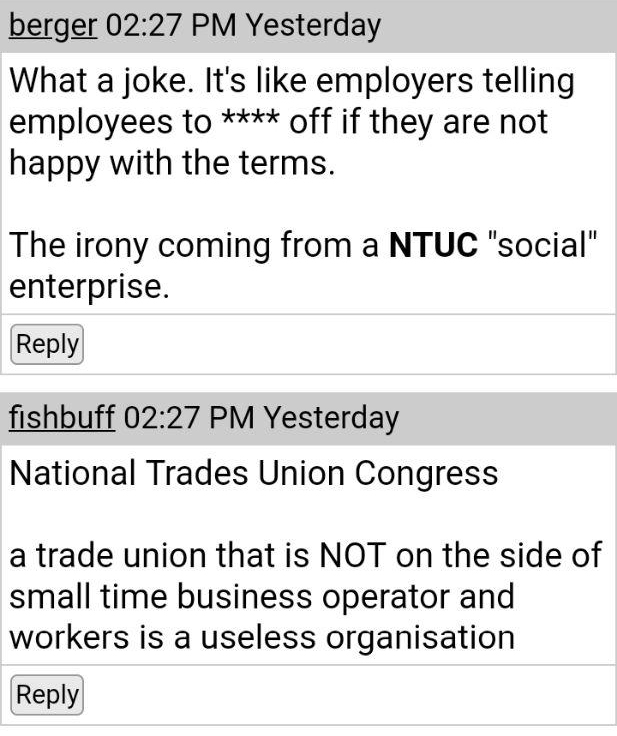
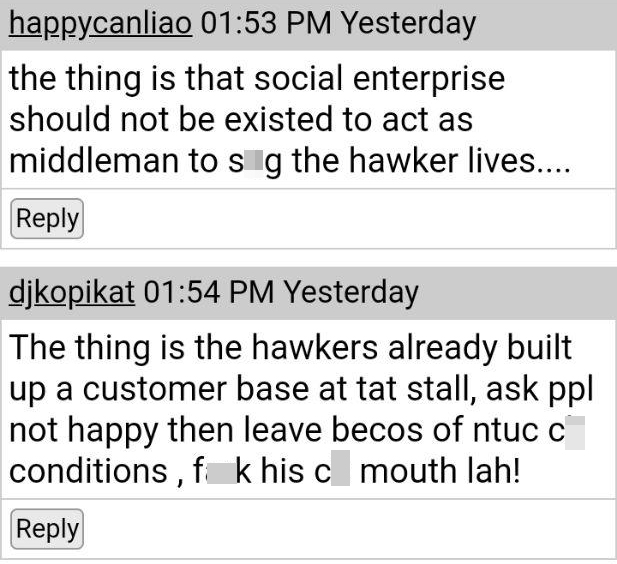
Some also pointed out that Ong dodged the question about profiteering off hawkers.
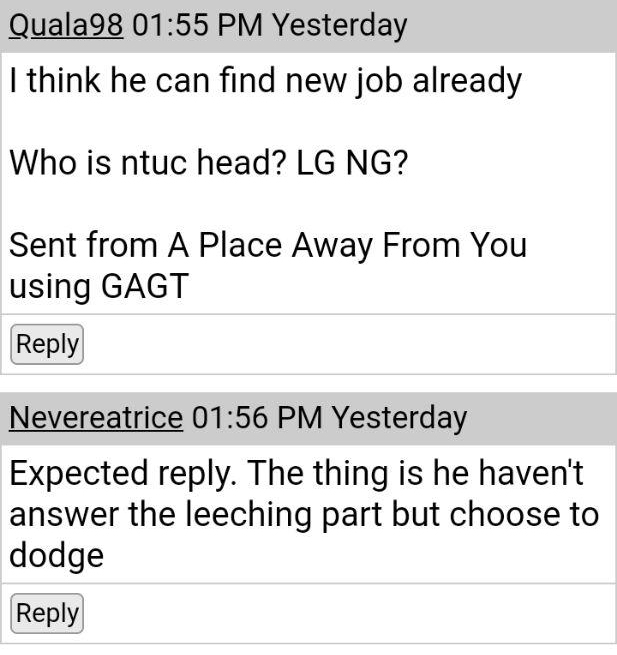
Revisions to article
The next thing we noticed was that Vulcan Post's article went through at least two headline changes throughout the day before it was eventually removed altogether later in the evening.
Here's the initial headline it carried:
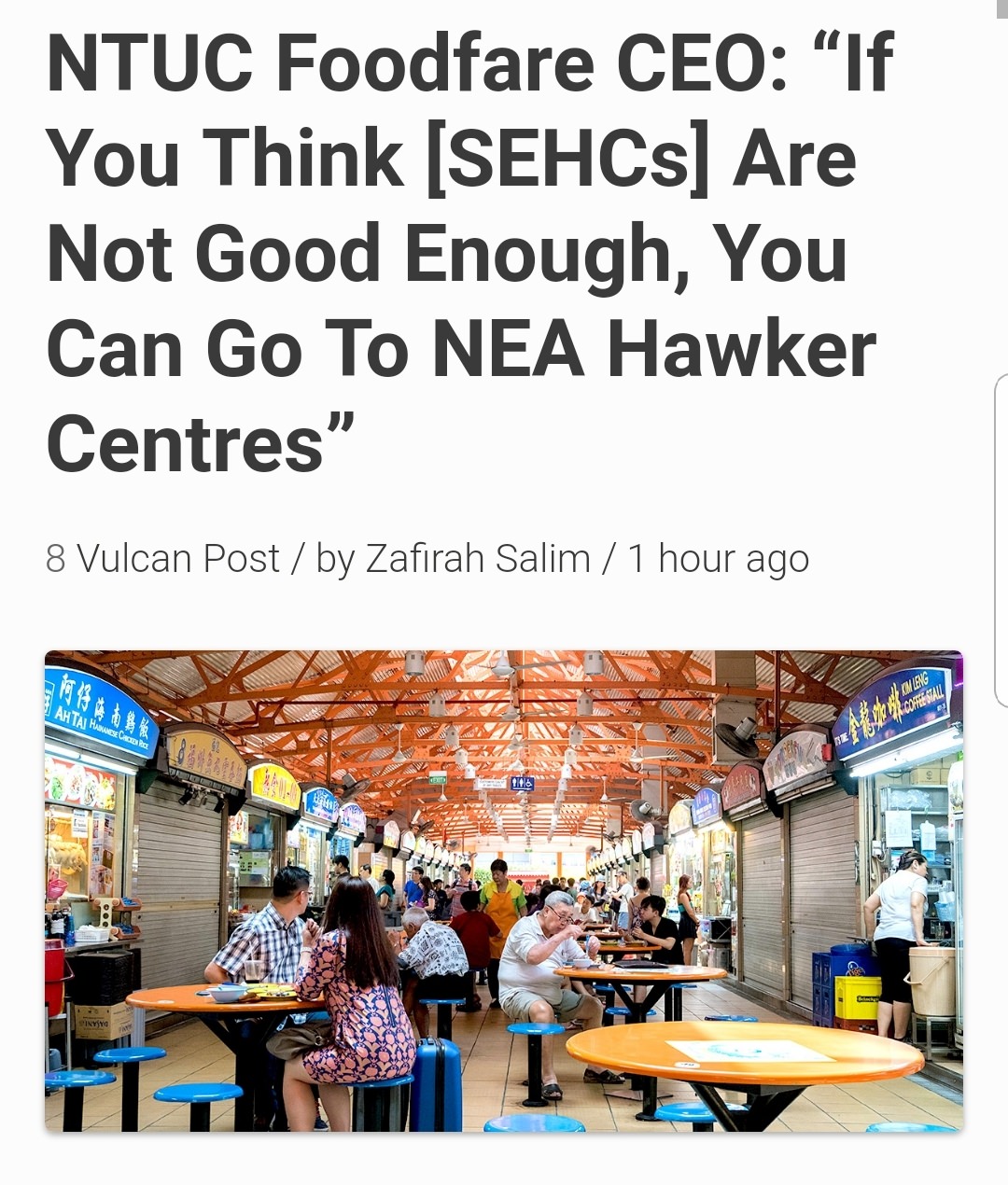
It was then modified to this:
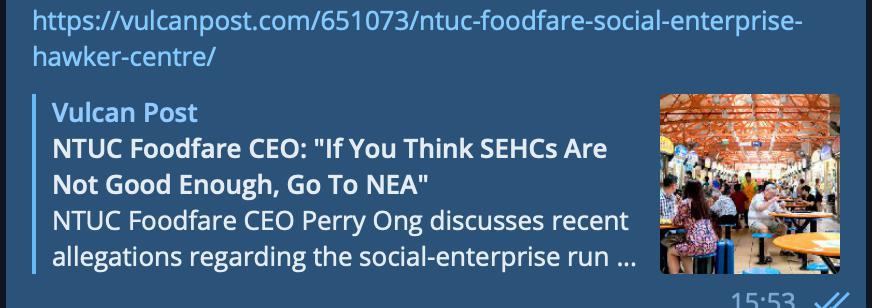
And then this:
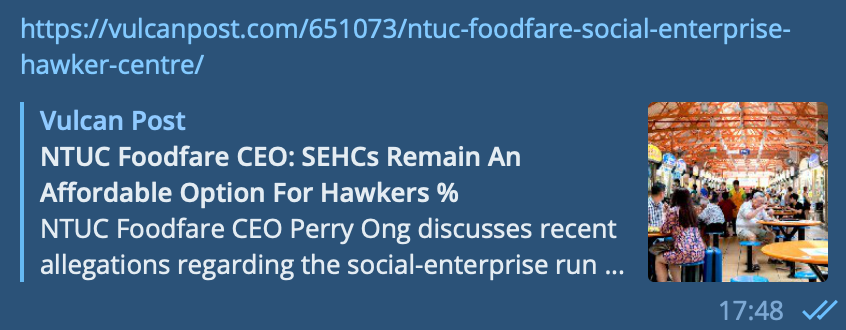
Before it was eventually taken down altogether:

NTUC Foodfare: Headline taken out of context
When we asked NTUC Foodfare about the curious disappearance of the Vulcan Post article, a spokesperson told us
a) The article was based off a media engagement session that was not a deliberate sit-down interview for explicit reporting;
b) It had highlighted to Vulcan Post that it believed the headline Vulcan had initially chosen was taken out of context; and
c) It also highlighted factual inaccuracies in Vulcan Post's article, hence it was taken down for editing and will be republished when the changes were complete.
Here is its statement shared with Mothership:
"NTUC Foodfare noted the report by Vulcan Post (VP) and subsequently contacted the editor to highlight that the headline was quoted out of context. NTUC Foodfare CEO, Mr Perry Ong has shared with VP for their background knowledge of SEHCs and it was not an intended interview for reporting.
Mr Perry Ong was putting across the point that given the various F&B retail formats available, hawker centre offers a low barrier of entry for aspiring hawkers. However, he understands that some hawkers may feel that SEHCs are not suited for them, they may consider non-SEHCs, which do have available stalls. At the same time, we have shared with VP on some factual corrections."
A brief catch up on the issue of social-enterprise hawker centres:
Social enterprise-run hawker centres (SEHC) came into the limelight recently when food critic KF Seetoh revealed that hawkers in one particular SEHC had to pay hidden charges on top of their monthly rent — a rather dubious monthly "spot check fee" of S$600 and rental of cashless payment system, to name two examples — all of which were not included upfront in their contract with the operator.
It soon emerged that hawkers in other SEHCs were also facing problems.
Over at Jurong Hawker Centre, hawkers had to pay an incentive to customers who returned their trays.
The issue blew up and was even discussed in Parliament, where Senior Minister of State for the Environment Amy Khor reiterated that extra charges levied on hawkers must be cleared with the National Environment Agency (NEA).
Most recently over the weekend, NEA announced that new contracts between hawkers and SEHC operators will have greater flexibility from 2019, including having more options for operating hours and making adjustments to the termination clauses.
Top images via Hardware Zone.
If you like what you read, follow us on Facebook, Instagram, Twitter and Telegram to get the latest updates.
